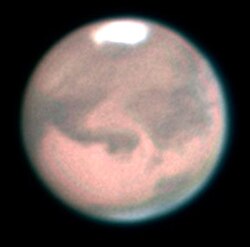Albedo feature

An albedo feature , ( German : Albedomerkmal ) is an area on the surface of a planet or another body in the solar system that is in contrast, in color or above differences in surface brightness ( albedo ), to the adjacent areas.
In the history of astronomy , albedo features were the first and mostly only features that were seen and named. B. on Mars and Mercury . First maps, like that of Schiaparelli , only showed these features, only with the availability of space probes it was possible to see other features such as impact craters . On planets other than Mars and Mercury, the albedo features are also called regio . On celestial bodies with a very dense atmosphere such as Venus or Titan , albedo features are not visible with normal optical means of observation, only atmospheric phenomena can be observed. The first feature discovered on another planet was Syrtis Major on Mars, it was discovered in the 17th century. Due to the availability of high-resolution images from space probes, the classic nomenclature based on the albedo features has become somewhat out of fashion , but is still used for observations from Earth in amateur astronomy .
Individual evidence
- ↑ Technical dictionary astronomy in the Google book search
- Jump up ↑ Ley, Willy and von Braun, Wernher The Exploration of Mars New York: 1956 The Viking Press Pages 70-71 Schiaparelli's original map of Mars
- ^ Antoniadi's map of Mercury. In: nasa.gov. history.nasa.gov, accessed March 29, 2017 .
- ↑ Morton, Oliver: Mapping Mars: Science, Imagination, and the Birth of a World . Picador USA, New York 2002, ISBN 0-312-24551-3 , pp. 14-15.
- ↑ William Sheehan: The Planet Mars: A History of Observation and Discovery - Chapter 2: Pioneers . Retrieved January 5, 2015.
literature
- The Origins of Martian Nomenclature , TL MacDonald, 1971.
- The Planet Mars: A History of Observation and Discovery , William Sheehan.